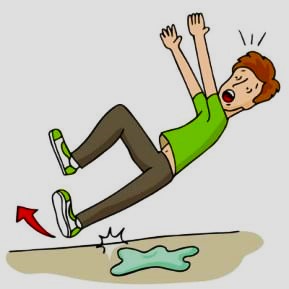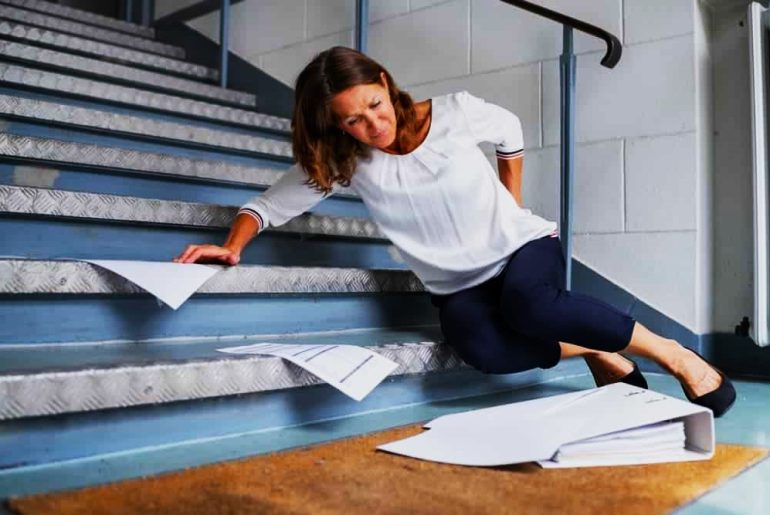Imagine walking down a supermarket aisle or strolling along a sidewalk, and suddenly, you find yourself on the ground, in pain. Slip-and-Fall Accidents, often trivialized as mere clumsiness, are in fact common occurrences with potentially severe consequences. These incidents don’t just leave bruises or broken bones; they can lead to a maze of legal and financial complexities that can be overwhelming.
When it comes to slip-and-fall accidents, understanding your rights and potential compensation is crucial. Here are three vital things to keep in mind:
- Shared Fault Impact: It’s important to realize that your compensation may be reduced if you’re found partly responsible for your injuries. The concept of shared fault plays a significant role in determining the final compensation amount. This is based on the principle that both parties involved in the accident may have contributed to the occurrence, and thus, the compensation is adjusted accordingly.
- Purpose of Compensation: The primary aim of compensation in slip-and-fall cases is to restore you to your pre-accident state, not to punish the defendant. It’s designed to cover your medical expenses, lost wages, and any pain or suffering you’ve endured. Remember, the goal is to help you recover from your losses, not to serve as a penalty for the property owner.
- Out-of-Court Settlements: A significant number of these cases are resolved through out-of-court negotiations rather than prolonged legal battles. This negotiation process often leads to a settlement that is agreeable to both parties, making it a preferred approach for its efficiency and lower stress levels.
Shared fault rules
In slip-and-fall accidents, determining responsibility is key, especially when more than one party is involved. Each state has specific personal injury laws that address scenarios where multiple parties share fault. It’s crucial to understand how these shared fault rules can impact your compensation in a slip-and-fall case.
Shared Fault Categories
The rules around shared fault generally fall into three categories:
- Contributory Negligence: Under this rule, if you’re found even partially at fault for your injuries, you may be barred from receiving any compensation. This strict approach is less common but critical to be aware of.
- Pure Comparative Negligence: This rule allows for compensation regardless of your level of fault. However, the compensation amount is adjusted based on your percentage of fault. For instance, if you’re found to be 30% responsible for the accident, your compensation will be reduced by 30%.
- Modified Comparative Negligence: Most states follow this rule. Like pure comparative negligence, it reduces your compensation based on your fault percentage. However, if you are primarily at fault (usually defined as 50% or more, or 51% or more, depending on the state), you may be ineligible for compensation.
State-Specific Rules
It’s essential to note that the application of these rules can vary significantly from state to state. Some states may be more lenient, allowing recovery even if you’re equally at fault, while others adopt a stricter stance, barring recovery at a lower threshold of fault.
Why Understanding Shared Fault is Important?
Understanding the nuances of shared fault rules in your state is crucial in a slip-and-fall case. These rules can significantly influence the compensation amount you’re eligible to receive. Being partially responsible for your accident doesn’t necessarily mean you can’t recover damages, but it can affect the total amount.
Navigating the complexities of shared fault rules can be challenging. That’s why it’s beneficial to have an experienced slip-and-fall attorney by your side. They can help you understand the specific laws in your state, assess your level of fault, and guide you through the process to ensure you receive the maximum compensation possible.
Compensation in Slip-and-Fall Accidents
In the aftermath of a slip-and-fall accident, understanding the scope of available compensation is crucial. The primary objective of this compensation is to restore you to your pre-accident state, not to provide financial gain. It’s about making you whole again, covering the full extent of your losses stemming from the accident.
Broad Spectrum of Compensation
Your entitlement in a slip-and-fall case typically includes:
- Medical Bills: All immediate and ongoing medical expenses incurred due to the accident are covered. This includes hospital stays, surgeries, medications, and any other medical treatments.
- Future Medical Care: If your injury necessitates long-term treatment or therapy, compensation can include the costs for these anticipated medical needs.
- Lost Income and Wages: Any earnings lost due to time off work for recovery or treatment are recoverable.
- Reduced Earning Capacity: If your injury impacts your ability to earn in the future, compensation can reflect this loss of earning potential.
- Pain and Suffering: Non-economic damages like physical pain, emotional distress, and reduced quality of life are also considered.
- Loss of Consortium: This relates to the impact of your injuries on your relationship with your spouse or family.
- Other Related Expenses: Additional costs like modifications to your home for accessibility (e.g., wheelchair ramps) are also compensable.
The Exception: Punitive Damages
It’s important to note that punitive damages in slip-and-fall cases are rare. These damages are not about compensating you but are intended to punish the defendant for particularly egregious behavior, such as intentionally destroying evidence. They go beyond mere compensation and serve as a deterrent for future misconduct.
Why Legal Assistance Matters
Navigating the complexities of compensation in slip-and-fall cases can be challenging. Each element of compensation requires clear evidence and accurate valuation. This is where legal expertise comes into play. An experienced slip-and-fall attorney can help you understand your rights, accurately assess your losses, and advocate for a compensation package that truly reflects the extent of your damages.
Why Most Slip-and-Fall Cases Settle Out of Court?
In the legal landscape of slip-and-fall cases, it’s a common trend to settle disputes outside of court. The journey to these settlements is a tactical one, often driven by the expertise and experience of legal professionals on both sides.
The Art of Negotiation
Most slip-and-fall cases are resolved through settlements, reflecting a mutual agreement reached through intense negotiation. These negotiations are guided by:
- The Extent of Your Losses: Your medical expenses, lost wages, pain and suffering, and other damages play a pivotal role in determining the settlement value.
- Your Responsibility in the Accident: If you hold some responsibility for the accident, it can influence the settlement offer. Comparative fault rules may reduce the compensation amount proportionate to your degree of fault.
Factors Influencing Settlements
The negotiation process takes into account various factors, with the severity of your injuries often being the most critical. A catastrophic injury, for instance, can prompt the defendant to settle, as they may wish to avoid the uncertainty and potential high verdicts of a court trial. On the other hand, if you are deemed partially responsible, the settlement offer may be comparatively lower.
The Role of a Personal Injury Attorney
Navigating these negotiations requires skill and understanding of the legal system. Having a seasoned personal injury attorney can significantly impact the outcome of your claim. An experienced attorney brings:
- Expertise in evaluating the true value of your claim,
- Knowledge of similar past cases to inform the negotiation,
- Skills in effectively communicating and bargaining with the opposition,
- The ability to protect your rights and maximize your compensation.

Understanding Premises Liability in Slip-and-Fall Lawsuits
At the heart of a slip-and-fall lawsuit is the concept of premises liability. This legal principle is what may hold property owners, occupiers, or managers accountable for accidents occurring on their property due to unsafe conditions.
The Foundations of Premises Liability
While premises liability laws vary from state to state, many follow principles similar to those in California. To establish a strong premises liability case, you generally need to prove the following:
- Control of Property: The defendant (property owner/manager) must have owned, leased, occupied, or controlled the property in question.
- Negligence in Maintenance: It must be established that the defendant was negligent in maintaining the property, leading to unsafe conditions.
- Injury to the Plaintiff: As the plaintiff, you need to demonstrate that you were harmed due to these conditions.
- Causation: A direct link must be established between the defendant’s negligence and your injury.
Identifying Unsafe Conditions
In slip-and-fall cases, various forms of negligence can create hazardous conditions, including:
- Slippery Surfaces: Caused by puddles of liquid, spilled products, or other wet surfaces.
- Ice and Snow: Unattended icy sidewalks or parking lots during winter.
- Loose or Torn Carpeting: Especially in high-traffic areas.
- Uneven or Damaged Flooring: This includes cracks, potholes, or uneven tiles.
- Obstructions: Protruding objects in walkways can create trip hazards.
- Broken Stairs or Railings: These can lead to falls and serious injuries.
- Lack of Adequate Signage: Failure to warn visitors of potential hazards.
The Significance of Premises Liability
Understanding premises liability is crucial because it determines how responsibility is assigned in slip-and-fall accidents. Proving negligence is key to a successful claim, as it helps establish the property owner’s liability for the unsafe conditions that led to the accident.
Navigating the complexities of premises liability requires legal expertise. An experienced attorney can help gather evidence, demonstrate negligence, and articulate how the unsafe conditions directly caused your injuries. With professional legal guidance, you can effectively pursue the compensation you deserve for your injuries.
Understanding the Severity of Slip-and-Fall Injuries
Contrary to common belief, slip-and-fall accidents can result in far more than minor scrapes or bruises. Especially for older individuals or those unable to break their fall, these incidents can lead to severe, life-altering injuries, and in extreme cases, they can even be fatal.
Common Injuries from Slip-and-Fall Accidents
Victims of slip-and-fall accidents may suffer from a range of serious injuries, including:
- Broken or Fractured Wrists/Hands: Often occurring as a person tries to break their fall.
- Neck Injuries: Including whiplash, which can have long-term effects on mobility and pain.
- Back Injuries: Spinal cord injuries from falls can lead to chronic pain or even paralysis.
- Head Injuries: Concussions or traumatic brain injuries (TBIs), which can have profound and lasting cognitive impacts.
- Leg or Foot Injuries: These can affect mobility and independence.
- Serious Hip Injuries: Particularly dangerous in older adults, hip injuries can lead to significant health complications.
- Bruises and Lacerations: These can range from superficial to severe, requiring medical intervention.
The Financial and Emotional Impact
The medical costs associated with these injuries can be astronomical, often running into hundreds of thousands of dollars. Beyond the immediate medical expenses, these injuries can drastically reduce your quality of life. When assessing compensation, attorneys and insurance adjusters often use a multiplier to calculate non-economic damages, such as pain and suffering. This calculation can significantly increase the average settlement amount in a personal injury lawsuit.
If you’ve experienced a slip-and-fall accident and believe premises liability applies, don’t hesitate to reach out to us. Our team of skilled attorneys is prepared to assess your case and advocate for your rights, ensuring you receive the justice and compensation you need for your recovery.




